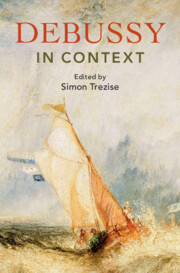Book contents
- Debussy in Context
- Composers in Context
- Debussy in Context
- Copyright page
- Dedication
- Contents
- Illustrations
- Contributors
- Preface
- Notes on the Text
- Abbreviations
- Part I Paris: City, Politics, and Society
- Part II The Arts
- Part III People and Milieu
- Part IV Musical Life: Infrastructure and Earning a Living
- Part V The Music of Debussy’s Time
- Chapter 23 Composing for Opera and Theatre outside Established Genres
- Chapter 24 Ballet and Dance
- Chapter 25 Orchestral Music and Symphonic Traditions
- Chapter 26 Chamber Music
- Chapter 27 Song and Choral Music
- Chapter 28 The Piano
- Part VI Performers, Reception, and Posterity
- Recommendations for Further Reading and Research
- Index
Chapter 28 - The Piano
from Part V - The Music of Debussy’s Time
Published online by Cambridge University Press: 23 May 2024
- Debussy in Context
- Composers in Context
- Debussy in Context
- Copyright page
- Dedication
- Contents
- Illustrations
- Contributors
- Preface
- Notes on the Text
- Abbreviations
- Part I Paris: City, Politics, and Society
- Part II The Arts
- Part III People and Milieu
- Part IV Musical Life: Infrastructure and Earning a Living
- Part V The Music of Debussy’s Time
- Chapter 23 Composing for Opera and Theatre outside Established Genres
- Chapter 24 Ballet and Dance
- Chapter 25 Orchestral Music and Symphonic Traditions
- Chapter 26 Chamber Music
- Chapter 27 Song and Choral Music
- Chapter 28 The Piano
- Part VI Performers, Reception, and Posterity
- Recommendations for Further Reading and Research
- Index
Summary
This chapter demarcates two eras of piano composition – pre-Debussy and post-Debussy – by taking as its focal point a comment made by the pianist Marguerite Long that since Debussy no one has heard or played the piano in the same way as it was played before. As crude as these delineations are, the goal is to emphasise the truly transformative nature of his approach to thinking about the piano in its entirety – as a technological machine, a source of unlimited and variegated sonority, and a catalyst for freeing the human imagination. While taking into consideration the pianistic tradition that Debussy was born into and the one that he was propelled towards – spurred on by the innovations of his contemporaries at the piano, including Gabriel Fauré, Emmanuel Chabrier, and Maurice Ravel – this chapter highlights Debussy’s uniquely refined sense of how the piano might be made to sound anew. By the turn of the twentieth century he was beginning to establish his status as a trailblazer at the keyboard. It would be up to his immediate successors, particularly the French composers Olivier Messiaen and Pierre Boulez, to extend the expressive potential of his engagement with the sensual, dramatic, and formal potentials of sound into a dimension that exploited aspects of acoustics and resonance.
- Type
- Chapter
- Information
- Debussy in Context , pp. 258 - 268Publisher: Cambridge University PressPrint publication year: 2024

